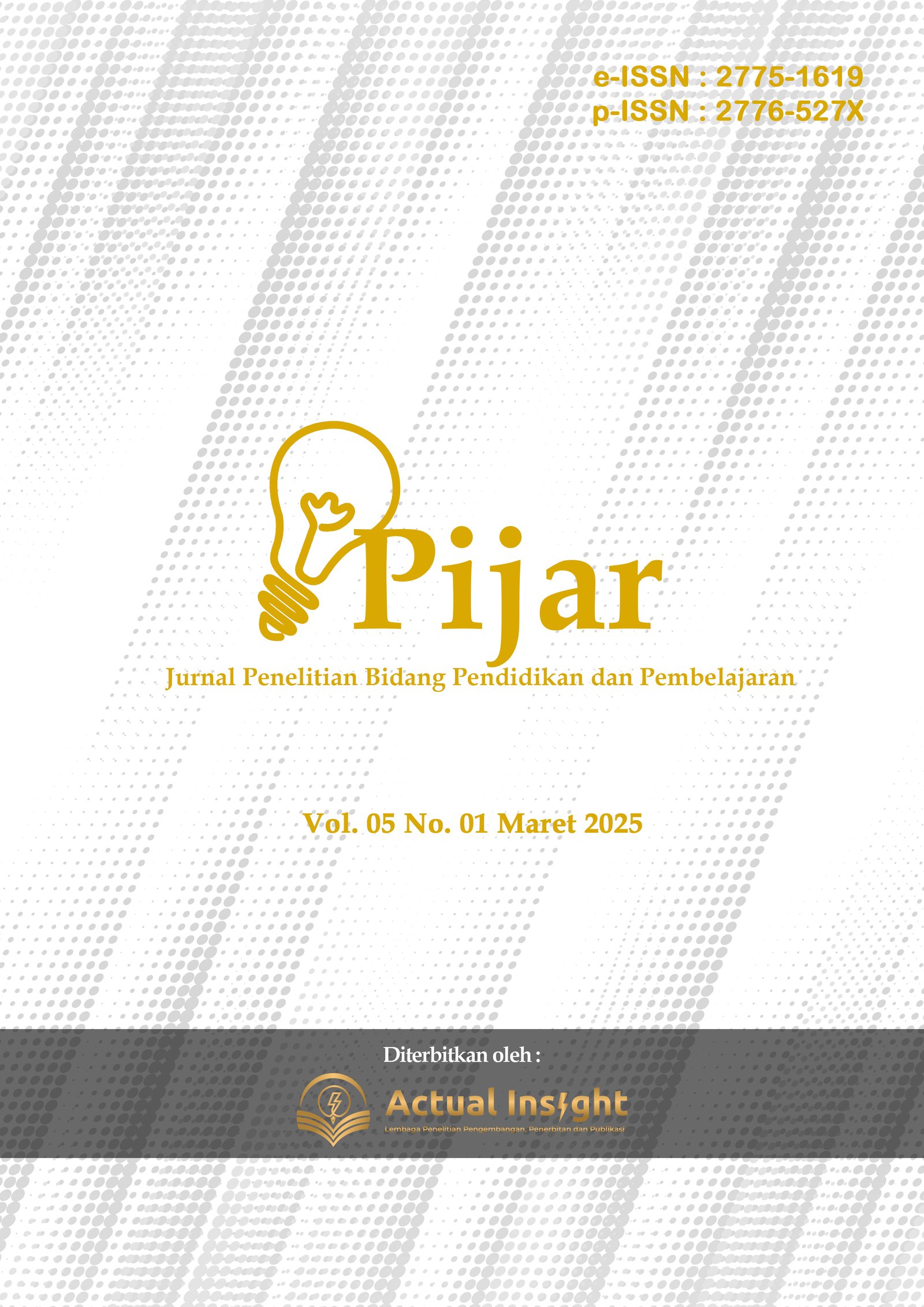Code-Mixing and Bilingualism in Indonesian Language Classrooms: A Case Study of Seventh-Grade Students in Riau
DOI:
https://doi.org/10.56393/pijar.v5i1.3396Keywords:
Code-mixing, Code-switching, Linguistic Glocalization, TikTok, Language LearningAbstract
This study explores the forms, functions, and social meanings of code-mixing and code-switching in a digital youth podcast broadcast on the TikTok platform. Adopting a descriptive qualitative approach and grounded in Grosjean’s critical sociolinguistic framework, the research analyzes the transcript of a conversational podcast episode featuring two Indonesian teenage girls discussing the topic of boyfriends versus best friends. The analysis reveals that code-mixing serves not only as a communicative strategy but also as an identity marker, a symbol of modernity, and a medium for expressing social solidarity among urban female youth. Conversely, code-switching is employed to mark topic shifts, emphasize emotions, and manage interpersonal dynamics during the podcast interaction. These bilingual practices reflect a process of glocalization, wherein youth flexibly mobilize multilingual resources within digital, media-rich contexts. The study underscores the pedagogical relevance of integrating authentic, digitally mediated discourse into language learning to enhance multilingual literacy and critical awareness. It also contributes to bilingualism studies by highlighting how identity and symbolic power are constructed through everyday linguistic practices in online spaces.
Downloads
References
Aditiawarman, M., Dewirahmadanirwati, D., & Ulya, R. H. (2025). Sociolinguistic insights into youth language phenomena: Patterns and influences in South Jakarta through the lens of Berita Akhir Pekan podcast. Al-Ishlah: Jurnal Pendidikan, 17(1), 707–719. https://doi.org/10.35445/alishlah.v17i1.6843
Androutsopoulos, J. (2006). “Multilingualism, diaspora, and the Internet: Codes and identities on German-based diaspora websites.” Journal of Sociolinguistics, 10(4), 520–547. https://doi.org/10.1111/j.1467-9841.2006.00291.x
Blommaert, J. (2010). The sociolinguistics of globalization. Cambridge University Press.
Bucholtz, M., & Hall, K. (2005). Identity and interaction: A sociocultural linguistic approach. Discourse Studies, 7(4–5), 585–614. https://doi.org/10.1177/1461445605054407
Busch, B. (2012). The linguistic repertoire revisited. Applied Linguistics, 33(5), 503–523. https://doi.org/10.1093/applin/ams056
Canagarajah, S. (2013). Translingual Practice: Global Englishes and Cosmopolitan Relations. Routledge.
Cope, B., & Kalantzis, M. (2009). “Multiliteracies: New Literacies, New Learning.” Pedagogies: An International Journal, 4(3), 164–195.
Creswell, J. W. (2014). Research design: Qualitative, quantitative, and mixed methods approaches (4th ed.). SAGE Publications.
Eckert, P., & McConnell Ginet, S. (2003). Language and Gender. Cambridge University Press. https://doi.org/10.1017/CBO9780511791147
Fadillah, N., Adila, N., & Purnama, T. A. (2025). The analysis of code-switching used by Cinta Laura and Yoshi Sudarso in Puella Podcast. Journal of Language and Literature, 8(1), 78–87. https://jurnal.uis.ac.id/index.php/JLL/article/view/4235
Fairclough, N. (1995). Critical discourse analysis: The critical study of language. Longman.
García, O., & Li Wei. (2014). Translanguaging: Language, bilingualism and education. Palgrave Macmillan.
Gultom, A. F. (2024). Objektivisme Nilai dalam Fenomenologi Max Scheler. De Cive : Jurnal Penelitian Pendidikan Pancasila Dan Kewarganegaraan, 4(4), 141–150. https://doi.org/10.56393/decive.v4i4.2107
Gumperz, J. J. (1982). Discourse strategies. Cambridge University Press.
Holmes, J., & Meyerhoff, M. (2003). The Handbook of Language and Gender. Blackwell Publishing.
Jannah, M. B., & Anggraini, D. (2023). Alih kode dan campur kode pada tuturan guru dan siswa dalam proses pembelajaran Bahasa Indonesia di kelas X SMA Negeri 1 2X11 Kayutanam. Educaniora: Journal of Education and Humanities, 1(1), 65–73. https://doi.org/10.59687/educaniora.v1i1.10
Kandiawan, B. (2023). Code switching and slang used by Gen Z Indonesians on social media. ELTR Journal, 7(1), 48–56. https://doi.org/10.37147/eltr.v7i1.165
Kelutur, F., Pattiasina, P. J., & Parinussa, J. D. (2023). Alih kode dan campur kode dalam pembelajaran Bahasa Indonesia siswa kelas XI SMA Negeri 16 Maluku Tengah. Jurnal Pendidikan Tambusai, 7(3), 20741–20747. https://doi.org/10.31004/jptam.v7i3.9560
Li Wei. (2011). Moment analysis and translanguaging space: Discursive construction of identities by multilingual Chinese youth in Britain. Journal of Pragmatics, 43(5), 1222–1235. https://doi.org/10.1016/j.pragma.2010.07.035
Li, W. (2018). “Translanguaging as a Practical Theory of Language.” Applied Linguistics, 39(1), 9–30.
Muysken, P. (2000). Bilingual speech: A typology of code-mixing. Cambridge University Press.
Page, R. (2012). Stories and Social Media: Identities and Interaction. Routledge.
Pegrum, M. (2014). Mobile Learning: Languages, Literacies and Cultures. Palgrave Macmillan.
Pennycook, A. (2007). Global Englishes and transcultural flows. Routledge.
Robertson, R. (1995). Glocalization: Time-space and homogeneity-heterogeneity. In M. Featherstone, S. Lash, & R. Robertson (Eds.), Global modernities (pp. 25–44). Sage Publications.
Rofik, A. (2023). Project based learning: EFL students’ involvement in collaborative writing. Journal of Language Intelligence and Culture, 5(2), 105–116. https://doi.org/10.35719/jlic.v5i2.127
Setyaningsih, E., & Wulansari, T. (2020). Code-switching and code-mixing in EFL classroom: A sosiolinguistic perspective. Jurnal Pendidikan Bahasa dan Sastra, 20(2), 115–130. https://doi.org/10.17509/bs_jpbsp.v20i2.27316
Sulistiyowati, S., & Fathurohman, I. (2024). Alih kode dan campur kode dalam pembelajaran Bahasa Indonesia pada era industri kreatif di SDN Bakaran Wetan 03. JANACITTA, 7(1), 38–45. https://doi.org/10.35473/jnctt.v7i1.2719
Sumarsih, Siregar, M., Bahri, S., & Sanjaya, D. (2014). Code switching and code mixing in Indonesia: Study in sociolinguistics. English Language and Literature Studies, 4(1), 77–88. https://doi.org/10.5539/ells.v4n1p77
Tagg, C. (2015). Exploring Digital Communication: Language in Action. Routledge.
Thomas, H., Stewart, M. A., Flint, P., & Dollar, T. R. (2020). Co learning in the high school English class through translanguaging: Emergent bilingual newcomers and monolingual teachers. Journal of Language, Identity & Education, 19(3), 194–212. https://doi.org/10.1080/15348458.2020.1726759
Wahyuni, R., Arifin, B., & Ramadhani, S. (2023). Code switching and social identity in the use of English among Indonesian millennial professionals. Indonesian Journal of Applied Linguistics, 13(2), 255–263. https://ejournal.upi.edu/index.php/IJAL/article/view/57723



